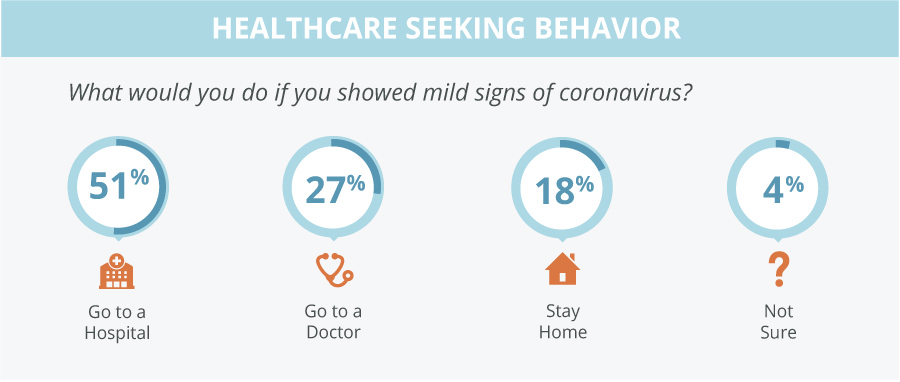Following GeoPoll’s first two reports on the impact of COVID-19 in sub-Saharan Africa, we are pleased to release results from our latest round of data collection. Data was collected from 10 countries, and we ran the same questionnaire as our last study in order to detect any shifts in behavior or concerns over time. Surveys ran from April 24th to May 8th 2020, with a total of 3994 respondents, 400 from each country except Rwanda, which had 394 respondents. The sample was roughly nationally representative by age, gender, and location within each country, and respondents for this study are part of a unique panel created following GeoPoll’s previous coronavirus study. You can jump to the dashboard of results below, and to request raw data or country-level demographic breakdowns by emailing [email protected]
Coronavirus Testing and Healthcare Behavior Changing
Although there has been a slow ramp-up of testing in many African nations, with tests per thousand people varying widely by country, GeoPoll’s data finds that reported testing has increased; 16% of respondents said they knew people who had tested negative for coronavirus, up from 12% in our first round of data collection, and 11% knew someone who had tested positive, up from 8%. There is also a slight increase in perceived risk of exposure; 66% say they believe they are at risk of being exposed to coronavirus, up from 63% in the earlier round of data collection.
In our last report, we noted that the percent who said they would go to a hospital if they exhibited mild symptoms of COVID-19 was quite high, at 58%, compared to just 13% who stated that they would stay home with mild symptoms. This subsequent round of data collection shows shifting attitudes towards healthcare-seeking behavior, with 51% stating they would go to the hospital, 18% reporting they would stay home, and 27% stating they would go to a doctor. This may indicate increased communication and awareness around treatment for mild cases of coronavirus in the countries studied.

Respondents report almost identical levels of preventative measures being taken when compared to the previous round of data collection, suggesting that respondents have not changed their habits much over the past few weeks, and a large portion are still avoiding public places and increasing hygiene. A slightly higher percentage than previously reported say they are now fully self-quarantining; 73% are self-quarantining now compared to 70% in the previous round of data collection.
We also found that the actions being taken by businesses to protect their consumers have shifted, with 34% now reporting that staff are in protective gear compared to 25% in the previous round, and 28% stating that store traffic is being limited, versus 25% in the previous round. A slightly lower percent, 53%, report that sanitizer is being offered in stores than the previous 57%, although this could be due to sanitizer shortages.
Shifts in Food Purchasing Behavior in sub-Saharan Africa
There is a strong likelihood that populations in sub-Saharan Africa and other regions will experience heightened levels of food insecurity due to COVID-19 and related restrictions on movement and market operability. Our last study showed high levels of concern over food availability, and 81% of respondents remain concerned over having enough food to eat. Additionally, we observe some shifts in food buying habits even within the past few weeks. While respondents indicate that food markets are gradually reopening in some areas, with 22% stating that most markets are open compared to 18% in the previous survey round, a slightly larger percent of respondents now report shopping for food more often than usual.
There are also shifts in the amount of food being purchased; while the previous round of data collection found that 22% said they were buying smaller packsizes than usual and 43% were buying larger packsizes than usual, the latest data shows that 28% are buying smaller packsizes and 39% bigger packsizes. This could indicate that towards the beginning of the crisis people were buying larger amounts of food, or could suggest that people are unable to afford large quantities of food, so are now purchasing smaller packsizes. Similar trends are seen in the brands being purchased; 79% of those who stated that they had worried about food availability report switching to a cheaper brand of food, versus 72% who said the same in the previous round.
Media Consumption During Coronavirus
We have looked at how information sources and media consumption are changing due to coronavirus in several of our reports; In Kenya, we found average television viewership had increased during COVID-19, and in Uganda, that news viewership specifically had risen. Our last round of data collection in 12 African nations also found that 66% reported an increase in media consumption. This round of data collection had similar results, with 65% reporting an increase in media consumption, although a slightly higher percent – 17% versus 15% from the first round – said they were consuming less media. Television and social media remain the top information sources overall, but on social media we find that more people are now turning to health organizations to get their news, with 25% stating they are getting information on social media from health organizations, compared to 22% in the previous round.
Results Dashboard
Future Studies on Coronavirus in Africa
GeoPoll will be running additional studies on how COVID-19 is impacting live throughout sub-Saharan Africa and other regions. To sign up for updates when we release a new report, please fill out the form below. To request pricing for custom studies related to coronavirus around the globe, please contact us.



